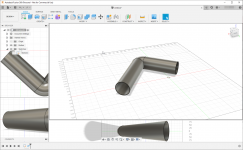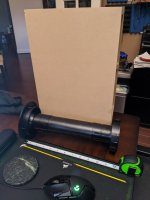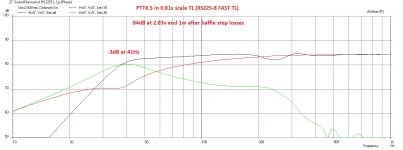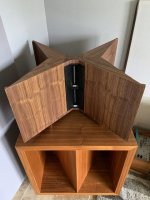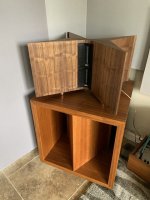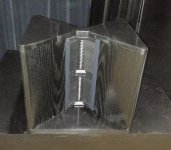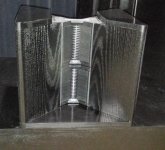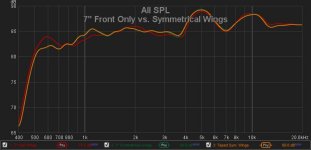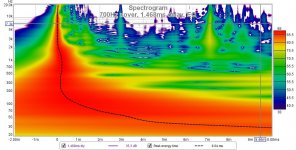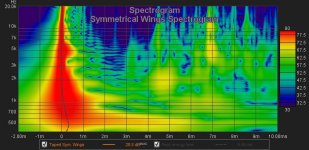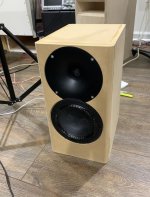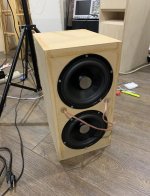Neither could I: sort of a "tune" to your needs based on the result.
Another option:
Dayton Audio DSA175-PR 6-1/2" Designer Series Aluminum Cone Passive Radiator
Another option:
Dayton Audio DSA175-PR 6-1/2" Designer Series Aluminum Cone Passive Radiator
Last edited:
I recon you’d need two of the Dayton 8” PRs to keep the Vd at least double that of the purifi maybe in a 25L box.. might be one path I’ll go down if my “purifi-99” slot ported box has issues.
I will post follow up listening notes with unconstrained volume levels. This is going to be so much fun.
You’re in for a treat. Get the fam out of the house, fix yourself a drink and kick back for the evening.
So for other cabinet-building noobs like myself, and to compare notes w/ those that are several steps ahead of me..
These are the dimensions I've tested using my Jasper jig:
5 3/4" cutout for the woofer
6 15/16" diameter for the flange/ rabbet
~ 4mm depth for the flange
Some photos of my progress so far:
Audio stuff - Album on Imgur
I'm just using a knockdown MDF cabinet from parts-express. I just glued & clamped the 1st one.
These are the dimensions I've tested using my Jasper jig:
5 3/4" cutout for the woofer
6 15/16" diameter for the flange/ rabbet
~ 4mm depth for the flange
Some photos of my progress so far:
Audio stuff - Album on Imgur
I'm just using a knockdown MDF cabinet from parts-express. I just glued & clamped the 1st one.
You're on the right track by the looks, its not as hard as you'd think, wait until you want to start building curved boxes. What volume is the PE cab and what are you doing for box alignment? - port, sealed, PRs?
You're on the right track by the looks, its not as hard as you'd think, wait until you want to start building curved boxes. What volume is the PE cab and what are you doing for box alignment? - port, sealed, PRs?
Thanks, I was hoping to replicate the major aspects of their ported SPK5 design with a 30hz tuning frequency. Which seems to require a rather long port, so I'll have to get creative.
This is the PE#300-7064 kit which is .56 cu feet in size. With a bit of added bracing, I'll be close to the 15L of the Purify design. Theirs also used 3d-printed flares on either end of the port... I purchased a PE flared-port kit, but it's 2" in diameter and 11" in length max. The port in the SPK5 was about 2.25" ID and 14.3" long. So my understanding is that if I stuck w/ 2 inches, I'd need something even longer to match!?
When you say "alignment", do you mean the box panels? I used an L-square to keep them at 90 degrees as I glued & clamped them. I need to get a proper band-clamp, though. But the kit itself is cut very well.. far better than I could ever do myself!
As to driver-alignment, i might offset the tweeter a bit just to give me more room for that port!
Thanks in advance for any guidance 🙂
I think if you stay with the port you’ve got and don’t extend it, you’ll be closer to a 35hz tune. If you want to go longer, you can use rainwater downpipes and elbows, use a round over router bit at the box exit as a flare and a heat gun to soften the internal port exit and create a flare that way.
My alignment question was answered - ported. Also smaller ports actually are shorter to get the same tuning, but the air velocity through them increases.
Try and maintain the same driver alignment as the spk4/5 paper, moving drivers further apart affects vertical directivity negatively unless the crossover is modified to suit.
My first test cabinets were just the spk4 port dimensions netting a 35hz tuning. 55mm ID about 230mm long. Flared both ends. Still - too much port noise in this alignment for my liking.
Here’s my next cabinet in progress and how I’m trying to overcome the ‘long bendy port’;
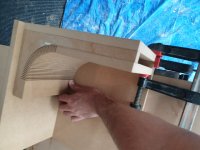
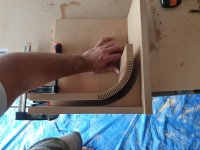
My alignment question was answered - ported. Also smaller ports actually are shorter to get the same tuning, but the air velocity through them increases.
Try and maintain the same driver alignment as the spk4/5 paper, moving drivers further apart affects vertical directivity negatively unless the crossover is modified to suit.
My first test cabinets were just the spk4 port dimensions netting a 35hz tuning. 55mm ID about 230mm long. Flared both ends. Still - too much port noise in this alignment for my liking.
Here’s my next cabinet in progress and how I’m trying to overcome the ‘long bendy port’;


Last edited:
I think if you stay with the port you’ve got and don’t extend it, you’ll be closer to a 35hz tune. If you want to go longer, you can use rainwater downpipes and elbows, use a round over router bit at the box exit as a flare and a heat gun to soften the internal port exit and create a flare that way.
My alignment question was answered - ported. Also smaller ports actually are shorter to get the same tuning, but the air velocity through them increases.
Try and maintain the same driver alignment as the spk4/5 paper, moving drivers further apart affects vertical directivity negatively unless the crossover is modified to suit.
My first test cabinets were just the spk4 port dimensions netting a 35hz tuning. 55mm ID about 230mm long. Flared both ends. Still - too much port noise in this alignment for my liking.
Here’s my next cabinet in progress and how I’m trying to overcome the ‘long bendy port’;
View attachment 842522
View attachment 842521
I cutout my 1st baffle a few nights ago and everything seems to fit pretty well. The port kit I got from PE just isn't gonna work in this little box... I think your curved slot configuration is the ideal way to go!

This kit from Parts Express is about 11" long, but the box is only 9.5" deep internally. The flares are also HUGE and would need a cutout over 4" in the back.
I finally got around to plugging this into WinISD and after a fair amount of reading, I'm starting to understand the port noise issues. To get the port velocity down to something near reasonable demands something bigger than the 2" PE kit anyway. That said, I've got a 3D printer (Prusa MK3s) and I'm going to attempt to make an angled 2.5" ID port that's about 17" long. Might even be able to swing 2.75" if the baskets don't get in the way!
Attachments
I have done similar model in WinISD and have realized the same issues.
I wonder if anyone is adventurous enough to do external port. It will make the speaker look rather interesting! I have a bunch of 2.5" and 3" pipes.
I wonder if anyone is adventurous enough to do external port. It will make the speaker look rather interesting! I have a bunch of 2.5" and 3" pipes.
My woofers will be arriving in a few days thanks to Norman Tracy's GB. So I am looking at some TL cabinet designs. My first lazy effort is to simply take my proven 8in woofer TL for the 10F/RS225-8 Transient Perfect FAST speaker (32Hz F3) and fantastic sounding, and scale it by 6.5/8 or 0.81x and see what Akabak spits out.
Here is the full scale design for the 8in woofer:
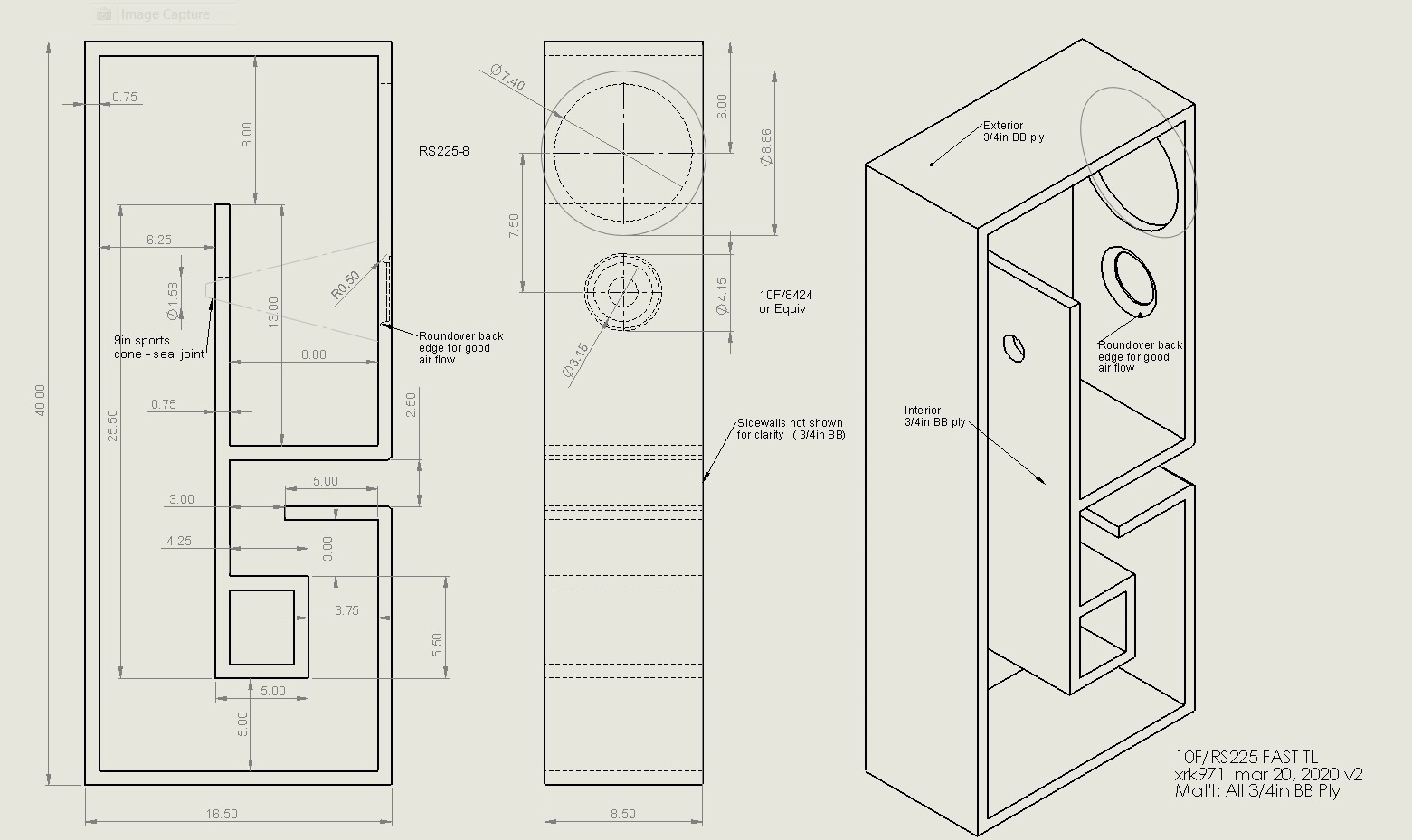
They look like this (lower ones):
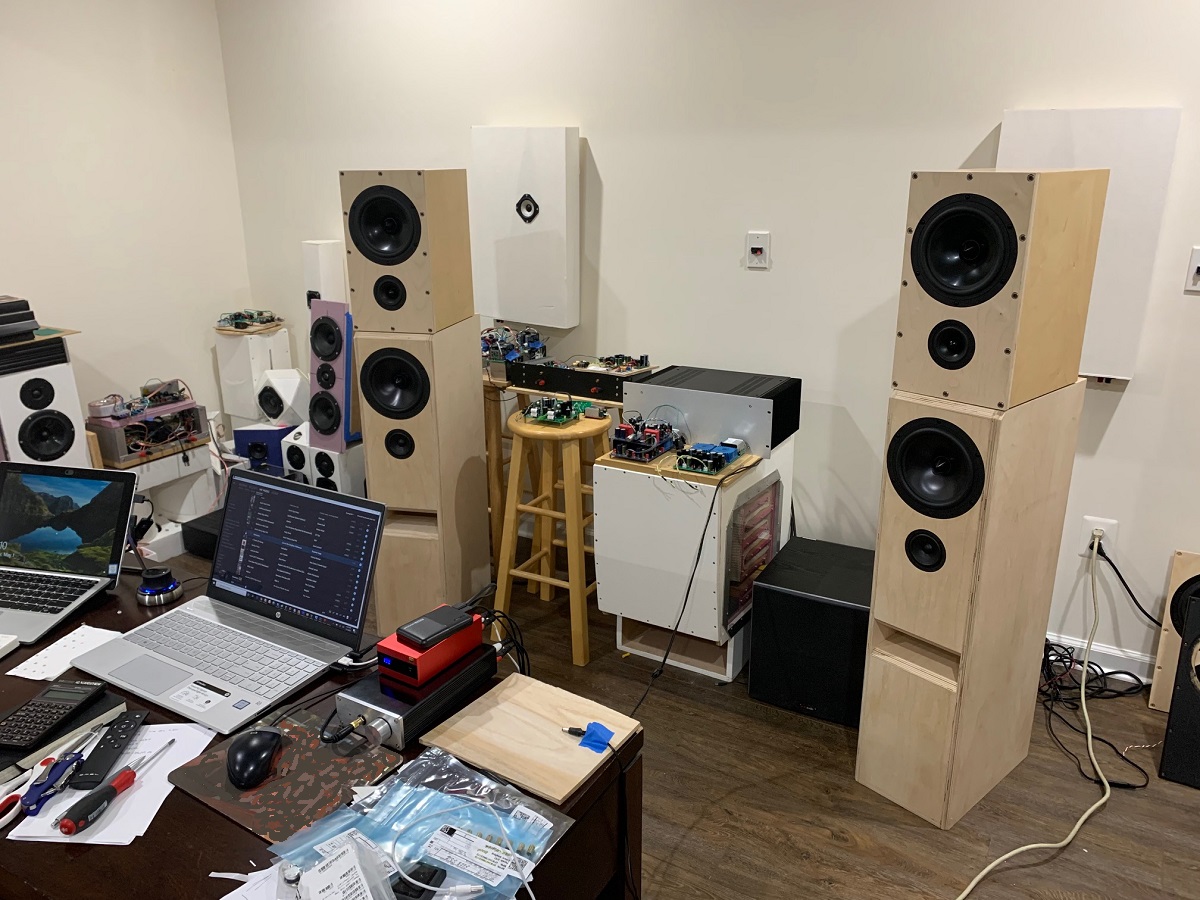
So here is the 0.81x scaling simulation - gives a 41Hz F3, which is nice as it hits the low E on a bass nicely.
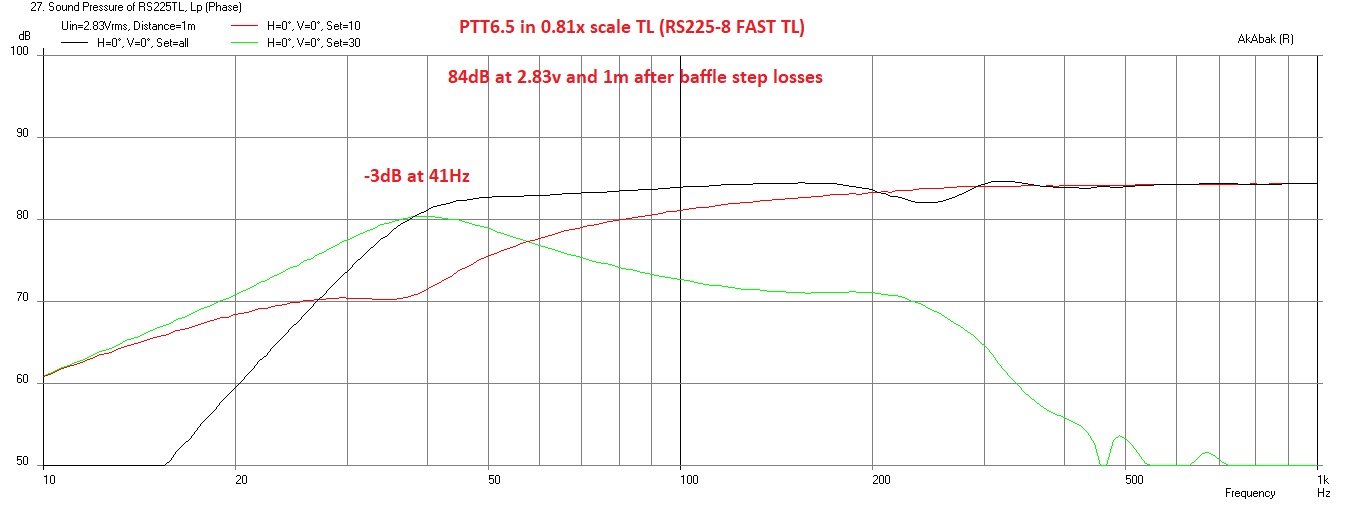
I would like to make it much more compact though. One thing I found that by going to a TL like this is that the midrange transparency really opened up by removing the back reflected energy driving a compressed sealed cabinet with the RS225. I am hoping similar benefits exist here. I am also liking how the FAST setup with a 1st order XO works so well here.
Here is the XO with a ScanSpeak 10F/8424 and RS225-8 before the TL mod extended the bottom to 32Hz:
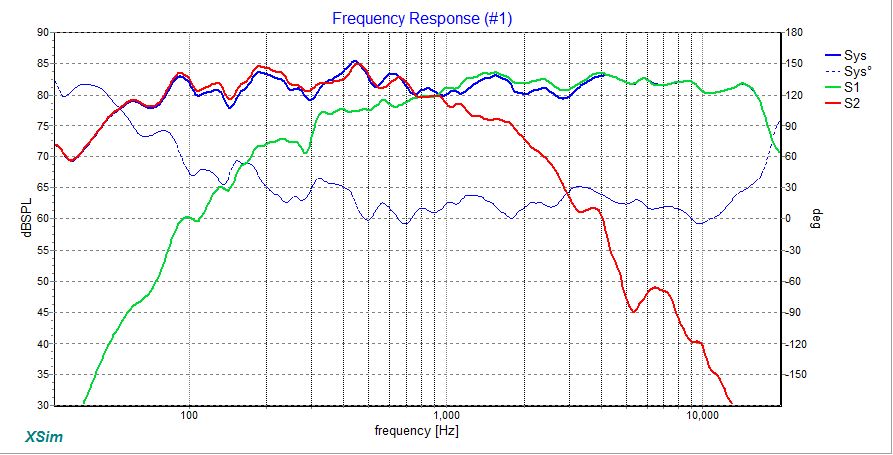
Seeing how the Purifi is such a wide bandwidth driver, I am hoping something similar can be done.
Here is the full scale design for the 8in woofer:
They look like this (lower ones):
So here is the 0.81x scaling simulation - gives a 41Hz F3, which is nice as it hits the low E on a bass nicely.
I would like to make it much more compact though. One thing I found that by going to a TL like this is that the midrange transparency really opened up by removing the back reflected energy driving a compressed sealed cabinet with the RS225. I am hoping similar benefits exist here. I am also liking how the FAST setup with a 1st order XO works so well here.
Here is the XO with a ScanSpeak 10F/8424 and RS225-8 before the TL mod extended the bottom to 32Hz:
Seeing how the Purifi is such a wide bandwidth driver, I am hoping something similar can be done.
Attachments
My woofers will be arriving in a few days thanks to Norman Tracy's GB. So I am looking at some TL cabinet designs. My first lazy effort is to simply take my proven 8in woofer TL for the 10F/RS225-8 Transient Perfect FAST speaker (32Hz F3) and fantastic sounding, and scale it by 6.5/8 or 0.81x and see what Akabak spits out.
Here is the full scale design for the 8in woofer:

They look like this (lower ones):

So here is the 0.81x scaling simulation - gives a 41Hz F3, which is nice as it hits the low E on a bass nicely.

I would like to make it much more compact though. One thing I found that by going to a TL like this is that the midrange transparency really opened up by removing the back reflected energy driving a compressed sealed cabinet with the RS225. I am hoping similar benefits exist here. I am also liking how the FAST setup with a 1st order XO works so well here.
Here is the XO with a ScanSpeak 10F/8424 and RS225-8 before the TL mod extended the bottom to 32Hz:

Seeing how the Purifi is such a wide bandwidth driver, I am hoping something similar can be done.
X,
I can’t wait for you to unleash your take on the woofers. Will be watching this space.
You realise what forum you’re on, right?
Hehe. I also have a more conventional (on loan) RAAL ribbon that I can try crossing at circa 2kHz. But is compulsory 4th order.
And a Heil AMT that I can cross as low as 800Hz.
And an RS28F in a WG300 waveguide that would be really nice. This box had dual 6.5in passive radiators already installed and an approximate drop in cutout waiting for the Purifi!
Lots of choices!
Do you guys feel that -3dB of 41Hz is not low enough for this woofer? Looks like people are designing tiny boxes tuned to 32Hz or something with long long tubes or deeply weighted PR’s.
Hehe. I also have a more conventional (on loan) RAAL ribbon that I can try crossing at circa 2kHz. But is compulsory 4th order.
And a Heil AMT that I can cross as low as 800Hz.
And an RS28F in a WG300 waveguide that would be really nice. This box had dual 6.5in passive radiators already installed and an approximate drop in cutout waiting for the Purifi!
Lots of choices!
Do you guys feel that -3dB of 41Hz is not low enough for this woofer? Looks like people are designing tiny boxes tuned to 32Hz or something with long long tubes or deeply weighted PR’s.
I was contemplating using my woofers as OB midranges, but your idea looks very interesting and I look forward to more information.
To answer your question, personally, I would prefer 41Hz from a well designed TL to 32 in a ported enclosure. Part of this is that I have subwoofers I may use, but even then...
My woofers arrived! -- Thank you Norman for making this group buy happen!!!!!!
- I thought I would share a couple more options for the build, I know some were concerned about using an AMT-Heil Tweeter because of it not going low enough for an optimum crossover point ...But over on the Klipsch Community Forum they are stacking two ESS AMT-1 drivers and have found that if they put them into a front wave guide of 7-12 inches they have no problem with crossing over around a 1,000 Hz or even a little under that when using an active crossover , they also have found that if they use both a front and rear wave guide they can get down around 500- 600 Hz. for a crossover point! - One great thing about this approach is that distortion levels go WAY down with double stack of ESS AMT-1's in the wave guide ... and they can go Very loud effortlessly as well! Many of them are replacing their Klipsch, BMS, Altec and TAD Horn compression drivers with the double stack of AMT-1's and are VERY happy with the results! - The ESS AMT-1 was on sale for $150.00 , but I didn't commit soon enough and they are back at $170.00 now , but that is still a great deal considering what they use to cost. I will put up a couple of pictures of designs they have come up with so far to give a better idea of what they are up to.
- I thought I would share a couple more options for the build, I know some were concerned about using an AMT-Heil Tweeter because of it not going low enough for an optimum crossover point ...But over on the Klipsch Community Forum they are stacking two ESS AMT-1 drivers and have found that if they put them into a front wave guide of 7-12 inches they have no problem with crossing over around a 1,000 Hz or even a little under that when using an active crossover , they also have found that if they use both a front and rear wave guide they can get down around 500- 600 Hz. for a crossover point! - One great thing about this approach is that distortion levels go WAY down with double stack of ESS AMT-1's in the wave guide ... and they can go Very loud effortlessly as well! Many of them are replacing their Klipsch, BMS, Altec and TAD Horn compression drivers with the double stack of AMT-1's and are VERY happy with the results! - The ESS AMT-1 was on sale for $150.00 , but I didn't commit soon enough and they are back at $170.00 now , but that is still a great deal considering what they use to cost. I will put up a couple of pictures of designs they have come up with so far to give a better idea of what they are up to.
Attachments
Wow, nice wood work! And I like the stacked Heils a lot. Does the wave guide have negative side effects? E.g. in compression or coloring?
It could be a very nice two way line array speaker: 2-4 Purifi woofers in baffle or box with 2-3 Heils on top...
Fedde
It could be a very nice two way line array speaker: 2-4 Purifi woofers in baffle or box with 2-3 Heils on top...
Fedde
- Hi fedde , I don't remember any negative side effects..... the only thing that one person said was that if you enclose the top of the wave guide he felt like you loose a little of the Airiness ( is that a word?) and a little of the great Depth of Field - so that's why at this point most are leaving the AMT drivers in the wave guides open at the top. The only other downside was that AMT - Heil driver has very narrow vertical directivity - But that Disappears when you Stack Two of them! Some people are crossing them down around 500Hz , some around 700Hz , and some around 1,000Hz. I think it just comes down to the best pattern control for that set of drivers and what sounds best.
- This is a quote from one of the senior speaker guys over there --
- I've got a pair of Khorn clones in my computer room that have been gathering dust. If I retrofit a pair of the stacked/winged AMT-1s for the top hats, my guess is that they will completely blow away any set of Khorns that you've ever heard--because they will have:
- Consistent controlled directivity from 100 Hz to 20 kHz, at least 90 degrees of coverage horizontally,
- The absence of ceiling and floor bounce,
- Flat Phase,
- Vanishingly low modulation distortion even when playing very loudly (as most all fully horn-loaded loudspeakers have),
- Full time-alignment of the drivers,
- SPL vs. frequency will be flattened to probably within ±1.5 dB on-axis, and,
- The output above 400 Hz will all be via dipole radiator having almost no moving mass.
the same guy said later that he was so happy with the Stacked AMT-Heil wave guides that had replaced all the top horns in his Klipsch KHorn's and His Belle's .
- Here is a Spectrogram from some of their testing, this one is from a single pair of just the front wave guides , it has 1.3ms HF delay. NO EQ.
- And here is the second one with the Symmetrical Wings / Wave Guides
-----
- This is a quote from one of the senior speaker guys over there --
- I've got a pair of Khorn clones in my computer room that have been gathering dust. If I retrofit a pair of the stacked/winged AMT-1s for the top hats, my guess is that they will completely blow away any set of Khorns that you've ever heard--because they will have:
- Consistent controlled directivity from 100 Hz to 20 kHz, at least 90 degrees of coverage horizontally,
- The absence of ceiling and floor bounce,
- Flat Phase,
- Vanishingly low modulation distortion even when playing very loudly (as most all fully horn-loaded loudspeakers have),
- Full time-alignment of the drivers,
- SPL vs. frequency will be flattened to probably within ±1.5 dB on-axis, and,
- The output above 400 Hz will all be via dipole radiator having almost no moving mass.
the same guy said later that he was so happy with the Stacked AMT-Heil wave guides that had replaced all the top horns in his Klipsch KHorn's and His Belle's .
- Here is a Spectrogram from some of their testing, this one is from a single pair of just the front wave guides , it has 1.3ms HF delay. NO EQ.
- And here is the second one with the Symmetrical Wings / Wave Guides
-----
Attachments
Last edited:
I have crossed AMT Heils at 600Hz when in a synergy horn. The X born double stack looks way cool.
My Purifi drivers arrived as well. They measure beautifully with a DATS.
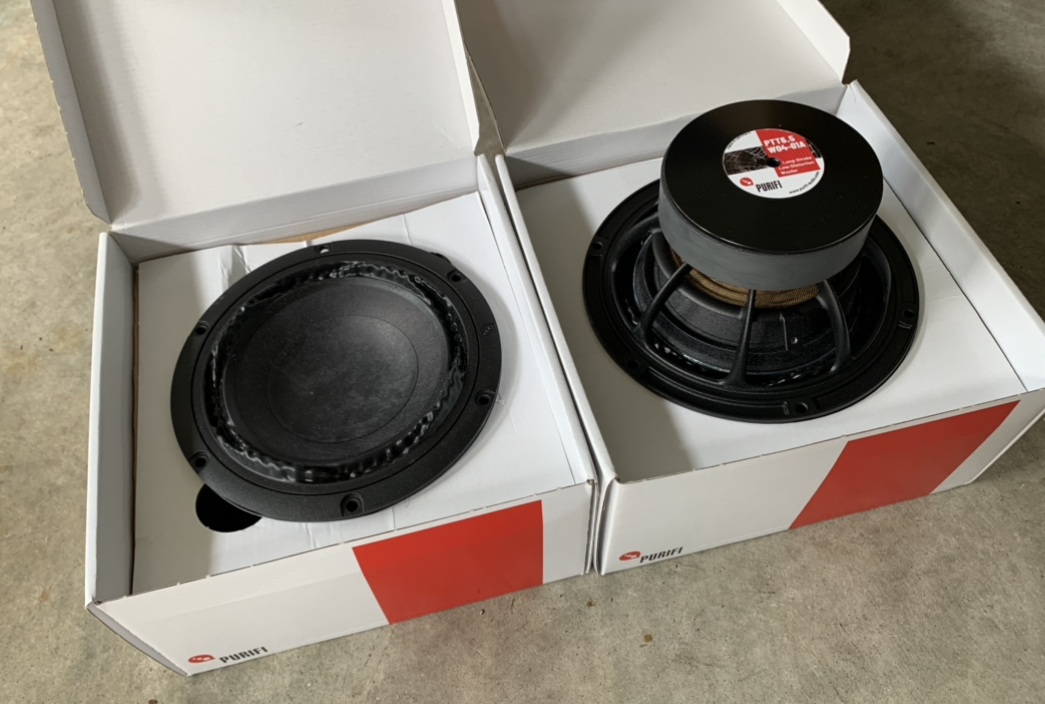
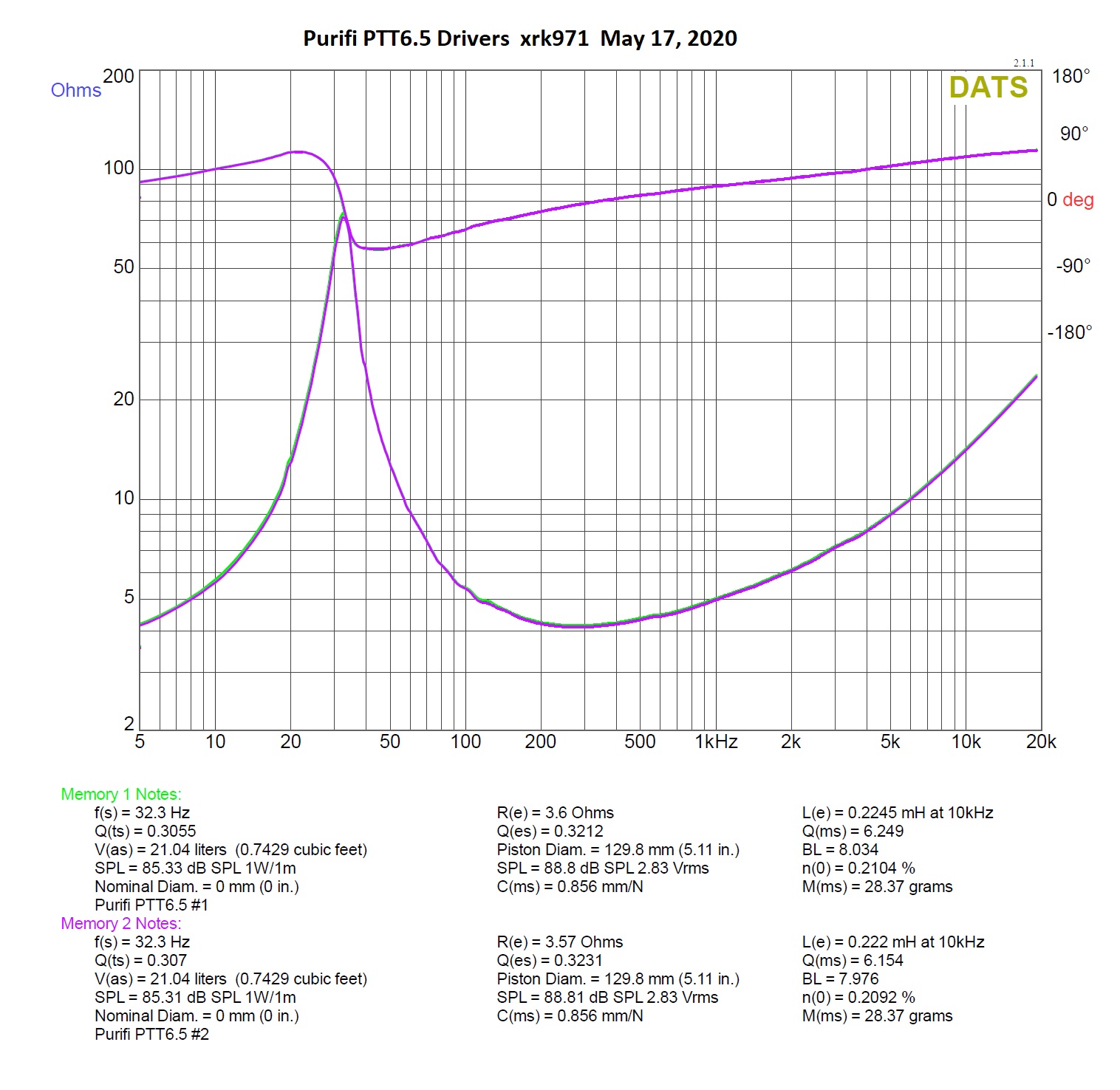
Qts, Fs, and SPL at 2.83v all match specs. The two drivers are almost identical in measurements. Very good uniformity of manufacturing.
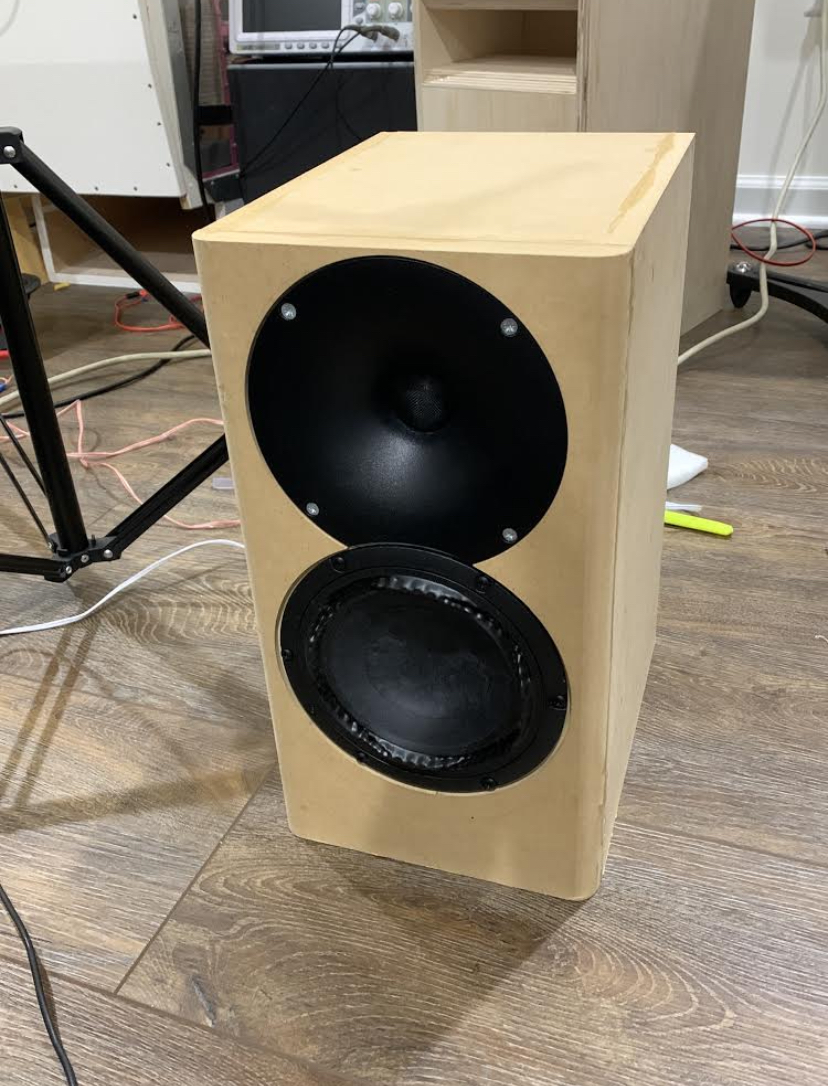
It turns out that the PTT6.5 is almost (smaller by 2mm on bezel OD) perfect drop in fit vs RS-180 from Dayton. I have a Denovo flat pack box (0.57 cuft) with RS28F in WG300 waveguide with Dayton 6.5 in passive radiators on back. I added 26gm SS metal discs to the passive radiators with hot melt glue (temporary). DATS sweep is showing box resonance of 36Hz.
Passive radiators w added mass:
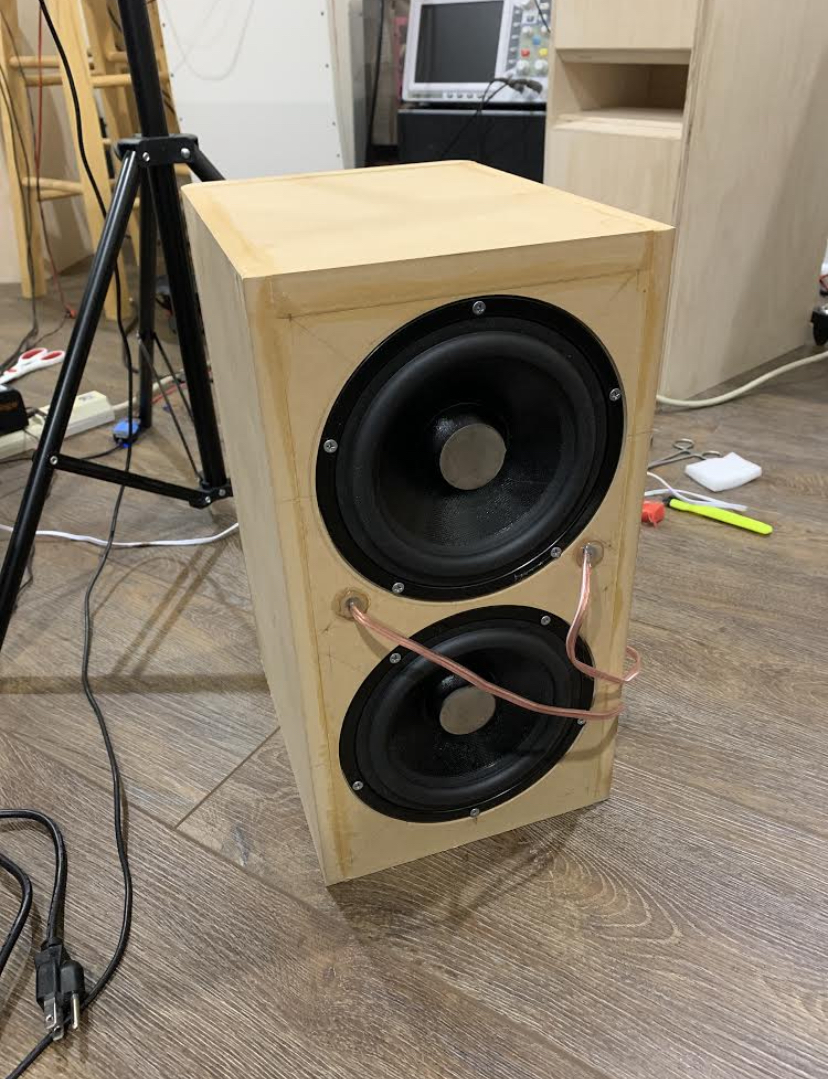
My Purifi drivers arrived as well. They measure beautifully with a DATS.
Qts, Fs, and SPL at 2.83v all match specs. The two drivers are almost identical in measurements. Very good uniformity of manufacturing.
It turns out that the PTT6.5 is almost (smaller by 2mm on bezel OD) perfect drop in fit vs RS-180 from Dayton. I have a Denovo flat pack box (0.57 cuft) with RS28F in WG300 waveguide with Dayton 6.5 in passive radiators on back. I added 26gm SS metal discs to the passive radiators with hot melt glue (temporary). DATS sweep is showing box resonance of 36Hz.
Passive radiators w added mass:
Attachments
Last edited:
- Home
- Loudspeakers
- Multi-Way
- Exploring Purifi Woofer Speaker Builds
